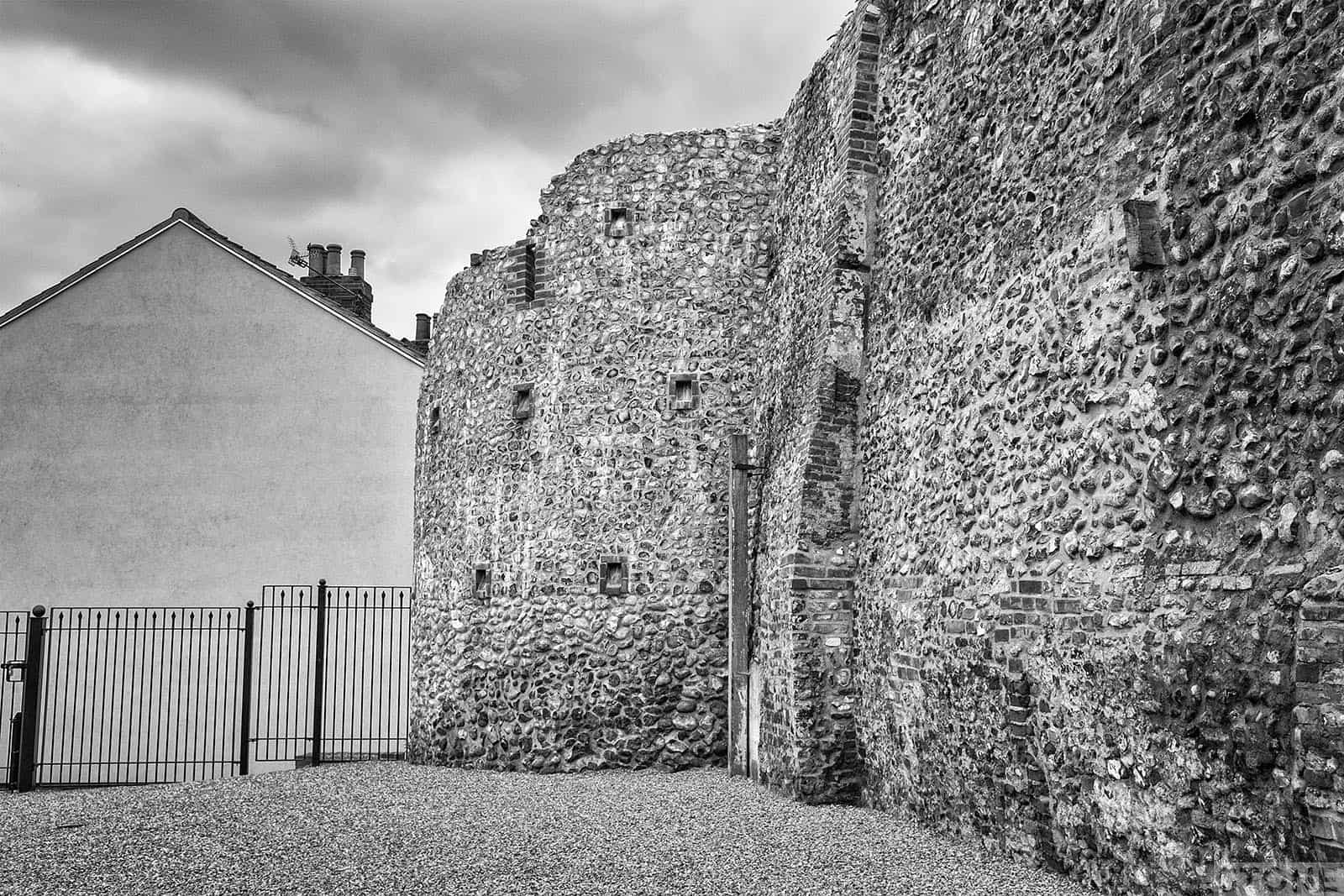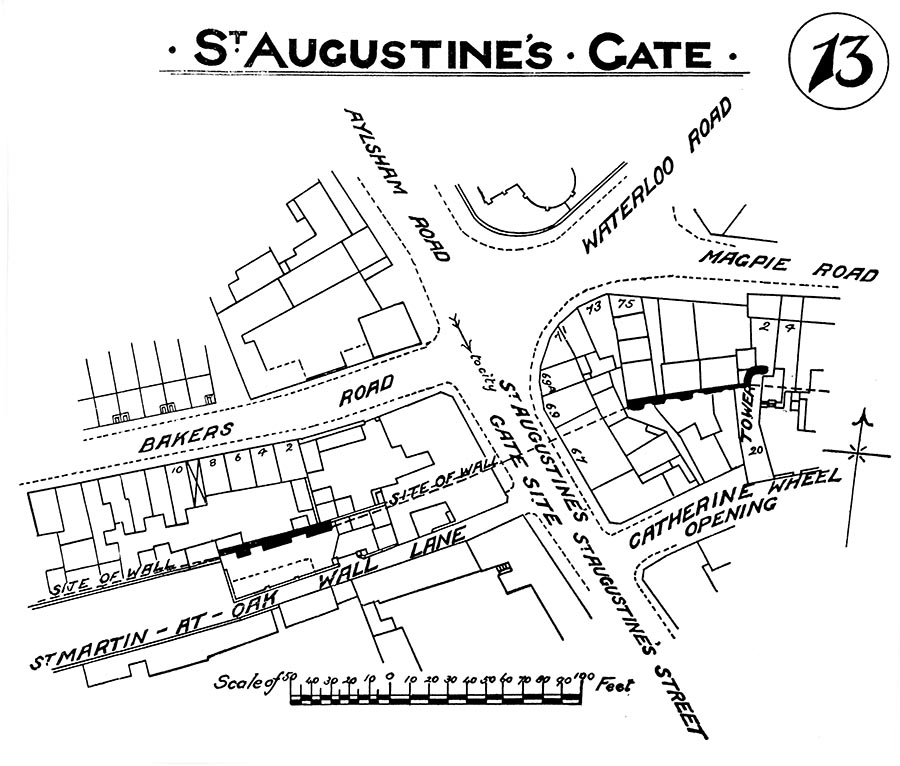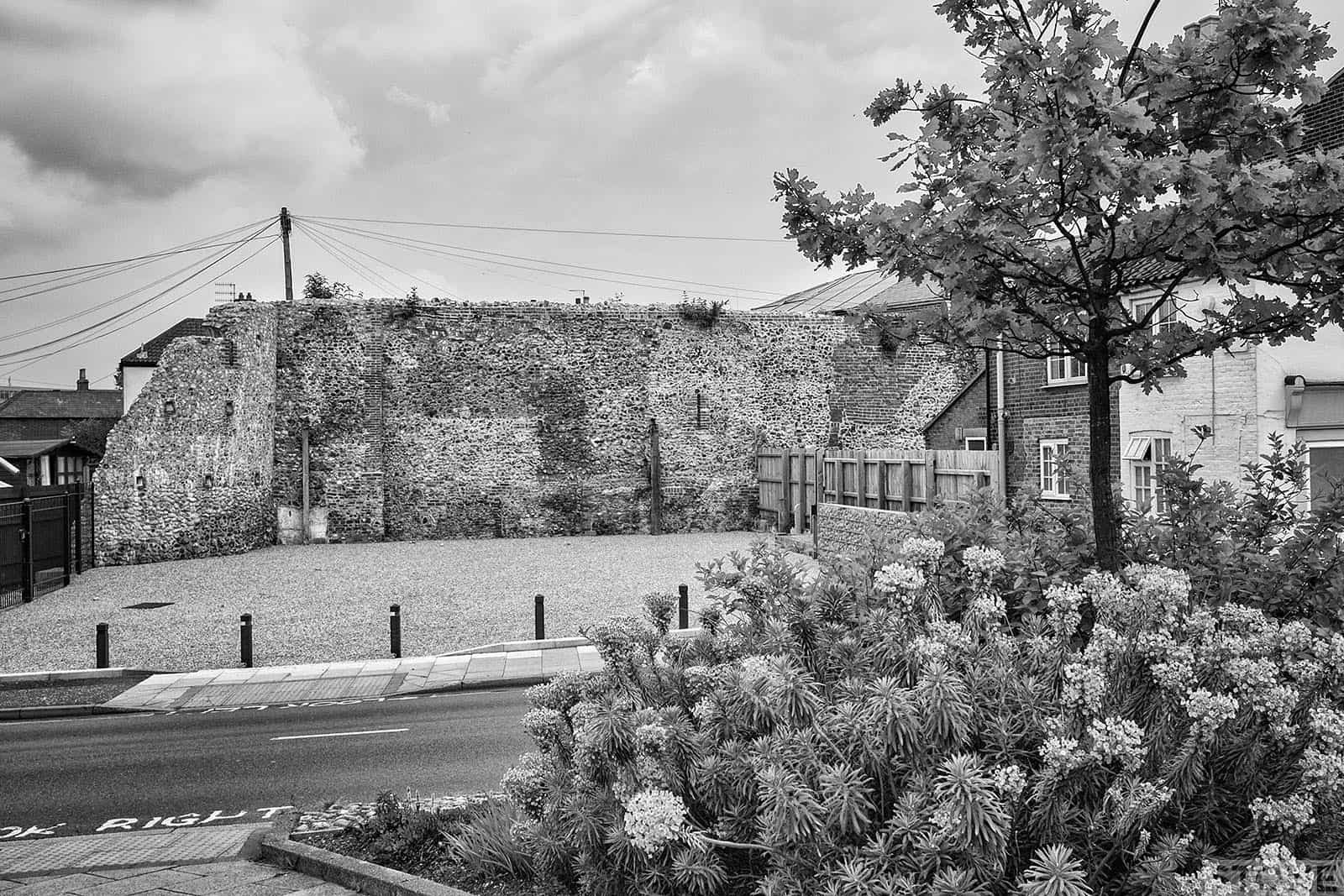This used to be the back wall of Magpie Print. I remember it being an inside; the inside of a building full of printing gear with ‘Mudpie Bob’ as we called him at the helm steering it. The trade seas were rough, from letterpress through to photolitho. I used to help him out with now-and-again with holiday cover, mostly producing phototypesetting from an old chugging Linotype – long glossy photographic galleys, to be chopped up with scalpels, glued down with hot wax on boards taped to a parallel motion table. All ready for the camera. This was design and artwork when it was a trade for most of us doing it.
It was a funny old building, wood-fronted with a curious lumpy concrete forecourt, fronted by a large opaque window and a set of permanently shut barn-doors dated back to when it was a garage and petrol station. It seems odd now in these days of the large faceless chain petrol stations and supermarket petrol that there was a pump on a forecourt here.
Magpie Road is part of a loop of almost-but-not-quite ring road. It very nearly became the ring-road with Compulsory Purchase Orders in place in the 1960s to buy it and the plot adjacent opposite the swimming pool. The other site was a ramshackle shed of a shop that had previously been a mortuary for the undertakers behind it. Then it became Swinton, now a beautician or an optician, I foget in the blur and sweep of time. Behind that lay what was Hubbard’s Radio which became Hubbards TV and then finally our studio for a while. Now it’s flats, cracks in the cheap render memory-marking the old shopfront.
It could have become a very different junction; the site of a large roundabout, the houses from here to Magdalen Gate gone and replaced by a wider ribbon of road. Baker’s Road would have been erased and a new bridge built across the Wensum off St Martin’s Road. No Magdalen Street flyover. It may have been better, the snaking ancient line of Magdalen Street not cut through worm-like under the blade of a spade. Plans move around and in a city that needs to make the best use of its routes The flyover; built on a cushion of runway rubble from airfields that Liberators and Flying Fortresses had temporarily thundered along during the late war years is what appeared, it was cheaper than building a bridge over a river on what had been marshland for millenia.
Magpie Print is comparatively recent history, the recent resurgence of letterpress as a craft rather than a trade has brought it back into my mind. It was one of those rather grimy, dark places, full of oily type and dusty paper, inhabited by that curious now largely retired breed who could read galleys of type backwards. The was a floor a carpet of paper dust and dried ink on lumpy concrete, above it tall plattern arms wiped the cobwebs from the ceiling in clattering strokes, machine-minders darted in and deftly grabbed stuck sheets in a way that would shatter your hand if you mistimed it. It was a small works, what had been the front garage turned into a setting-room, racks, plan chests and drawers full of type, comping and dissing tables in the middle of the room, old bent leading lying on the floor.
In the 1990s I went to see Bob about one thing and another. It was a sunny day, and what I unwittingly witnessed was the page turning. As with a lot of this old lead alloy and oily wood, the entire contents of the setting-room was dumped with no ceremony into a metal skip, the clattering chaff of a trade vanishing into landfill oblivion one drawer after another. “We got an Apple Mac and Quaark now” says Bob in his best Norfolk, all teeth, grinning broadly from under a Burt Reynold’s moustache, pointing proudly at his second hand already yellowing Quadra and a laser printer which could print onto paper plates or foils.
Bob let me have an empty type tray, I walked home with it wedged under one arm, plus a pile of Ribbon MT 18pt in a carrier bag. I have it still, the tray attached to the wall in various houses for over twenty years or more. Like most people mine is full of the wrong bits of history; clay pipe and rocks, bits of brick and pot. The type gone.

The building was partly wooden, rotten and leaking, the upstairs, At one time alleged to have doubled as a knocking shop had long since become uninhabitable. The back wall downstairs was covered with loose hardboard that pulled away to reveal the cold grey flint and brick chasing. We talked about it, Bob knew what it was. The kitchen which was unusable too, was in the old tower, the base full of reeds slumped down from the roof above. But it was there, this fascinating curve of a different structure – 700 years old, in a kitchen in a building that was slowly disintegrating. Eventually the building failed to a point where the Council said enough, and refused to renew the lease again.
Magpie print took the name of the road with it to an estate and carried on hammering out cards and menus using the old platterns to die cut, perforate and score in a lofty spacious clean tin shed. One age of print slowly dissipating under the growth of another. The building was boarded up, sat and rotted further, its eyes slowly sinking, skin peeling. Then one day it was pulled down replaced by hoardings which sat there for years masking the concrete base and the wall behind, the history an oil stain in the rain.
What we have now is an improvement I guess. I went and laid my hand on the flint and tried to place exactly where the old bits of the print shop were, you can still see the roof line and a couple of support timbers buried in the wall, There’s even a dark mark like a memory where the first floor starts, a dream of the rising dust and oil of the past.

The wall here vanishes under the line of houses in both directions, the gate was demolished in the late eighteenth century when the need to get produce and people in and out and the decayed state of the gates became too pressing. It’s a shame in some ways, but that’s how it works sometimes. Our distance in time being greater perhaps makes our concept of what is importance in heritage different from a city and it’s people and corporation two hundred years ago, but you only need to look at the comments under almost any news story about saving this chunk of history to see they haven’t changed as much as you may probably think. Looking at plans from 1909 the site hasn’t altered hugely in the last one-hundred years either. Flint and brick, putlog holes and an arrow loop ringed in brick, flint filled-gabions, a seat and gravel where a ditch stood, a house, a garage, a printworks. And the changing faces that have passed by.
From the 1909 report:
Its existence is recorded prior to 1272, and it was taken down in in 1794. Its name was sometimes curtailed to “St. Austin. It is the nearest tower to St. Augustine’s Gate. The remains of this tower are situated about 120 ft. to the East of the site of St. Augustine’s Gate.
They are incorporated and used as the scullery of No. 2, Magpie Road. with a bedroom over attached to No. 20, Catherine Wheel Opening.
The tower is semi-circular. There is a rumour in the neighbourhood of Magpie Road that the present Magpie public-house stands on the site of a tower. A
piece of the City’ wall crops out of the ground at the East side of this house, and in the cellar. is some rough masonry which may possibly have been the foundation of this tower, the second East of St. Augustine’s Gates. Measurements scaled off old plans confirm this as the site of this tower.

More wall sections here.


Excellent pictures Nick. You need to do that book on the city walls, your knowledge on the subject is second to none.
Thanks for this one too! I commented on another of your (unrelated) posts today and I happened upon this. The longer I live in Norwich the more interesting it becomes – many’s the time I have driven past Magpie printers and never given a second thought > once again thanks for this gem.
Great to learn more about a bit of the city I have often ridden through in the course of my work. I took some photos of the Magpie PH a few years back. not long after it closed. I wasn’t aware of much about the print works or the city wall in these parts. I know there was a hospital on hospital road (Waterloo Rd) but other than that I have much to learn. Thank you Nick
Would the proposed route of the inner link road be the reason they demolished the south side of Bakers Road?
Which area do you mean?
Hi nik. This is lee bobs son. Thanks for the memories